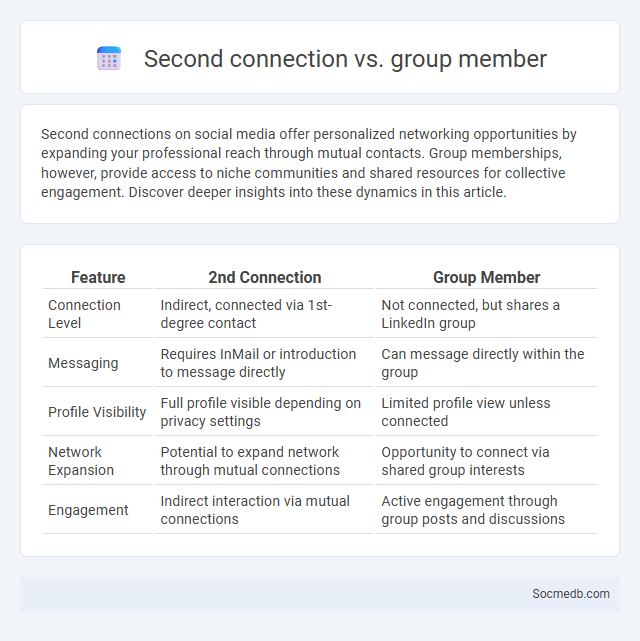
Photo illustration: 2nd connection vs group member
Second connections on social media offer personalized networking opportunities by expanding your professional reach through mutual contacts. Group memberships, however, provide access to niche communities and shared resources for collective engagement. Discover deeper insights into these dynamics in this article.
Table of Comparison
| Feature | 2nd Connection | Group Member |
|---|---|---|
| Connection Level | Indirect, connected via 1st-degree contact | Not connected, but shares a LinkedIn group |
| Messaging | Requires InMail or introduction to message directly | Can message directly within the group |
| Profile Visibility | Full profile visible depending on privacy settings | Limited profile view unless connected |
| Network Expansion | Potential to expand network through mutual connections | Opportunity to connect via shared group interests |
| Engagement | Indirect interaction via mutual connections | Active engagement through group posts and discussions |
Understanding LinkedIn Connection Degrees
LinkedIn connection degrees refer to how closely you are linked to other professionals within the platform, categorized as 1st, 2nd, and 3rd-degree connections. Your 1st-degree connections are people you are directly connected with, while 2nd-degree connections are those linked through your 1st-degree contacts, and 3rd-degree connections are even further away in your network. Understanding these degrees helps you strategically expand your professional network and engage with relevant opportunities on social media.
What Is a 2nd Degree Connection?
A 2nd degree connection on social media refers to someone who is connected to your direct (1st degree) connections but not to you personally. This level of connection often represents potential networking opportunities since you share mutual contacts, making it easier to establish trust or request introductions. Understanding 2nd degree connections is essential for expanding your professional or social network strategically.
Who Qualifies as a Group Member?
A social media group member is typically any user who has been approved or invited to join a specific online community or forum, meeting criteria set by the group administrator or platform guidelines. Membership qualifications often include factors such as age restrictions, location, interests, or professional affiliations, ensuring alignment with the group's purpose. Participation rights and access levels may vary, depending on whether the member is a standard participant, moderator, or administrator within the group.
Differences Between 2nd Connections and Group Members
2nd connections are people you are not directly connected with but share a mutual contact on social media platforms, allowing you to expand your network through introductions. Group members, however, are individuals who share a common interest or affiliation within a specific online group, providing a space for focused discussions and relationship-building around shared topics. Understanding these differences helps you strategically engage with your network for maximum social media impact.
Key Benefits of 2nd Degree Connections
Second degree connections on social media expand Your network by bridging gaps between direct contacts and new opportunities, increasing exposure to diverse industries and insights. These connections enhance trust and credibility, as they come through mutual acquaintances, making outreach more effective and personalized. Leveraging second degree connections accelerates professional growth and business development by unlocking hidden networks and potential collaborations.
Advantages of Connecting with Group Members
Connecting with group members on social media enhances collaborative opportunities, allowing users to share knowledge, resources, and support within specialized communities. These connections foster a sense of belonging and engagement, driving increased interaction and active participation. Access to diverse perspectives within groups also accelerates problem-solving and innovation through collective insight.
Connection Degree: Why It Matters
Connection Degree in social media measures the strength and number of relationships within a network, directly influencing information flow and user engagement. High connection degrees enhance content visibility, foster community building, and drive viral marketing potential. Brands leveraging strong connection degrees experience better customer loyalty and amplified reach across platforms like Facebook, Instagram, and LinkedIn.
Networking Strategy: 2nd Connections or Group Members?
Focusing on 2nd connections in social media networking leverages mutual trust and shared contacts, increasing the likelihood of engagement and collaboration. Targeting group members taps into niche communities with specific interests, facilitating highly relevant interactions and stronger relationship building. Both strategies optimize reach and influence by balancing broad exposure with targeted relevance in professional networks.
Expanding Reach: Leveraging Connection Degrees
Expanding reach on social media involves leveraging first, second, and third-degree connections to amplify content visibility and engagement. By targeting not only direct followers but also their extended networks, brands can tap into a broader audience, increasing the potential for virality and organic growth. Utilizing algorithms that prioritize interactions within these connection degrees enhances strategic targeting and maximizes outreach efficiency.
Choosing the Right Connection Path for Professional Growth
Selecting the right connection path on social media significantly impacts your professional growth by aligning your network with industry-relevant contacts and thought leaders. Targeting LinkedIn groups, industry-specific forums, and professional communities enhances your visibility and access to career opportunities. Your engagement strategy should prioritize meaningful interactions and content sharing that showcase your expertise and attract potential employers or collaborators.
 socmedb.com
socmedb.com